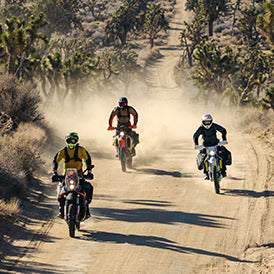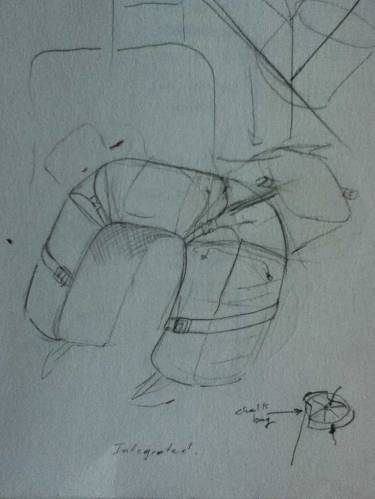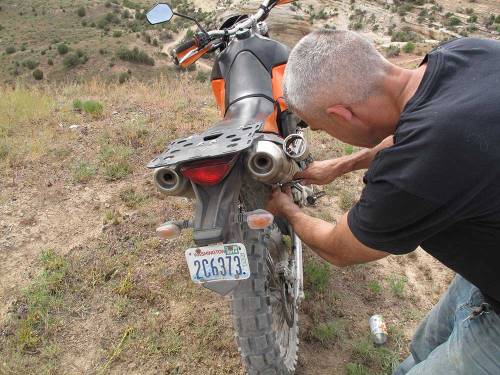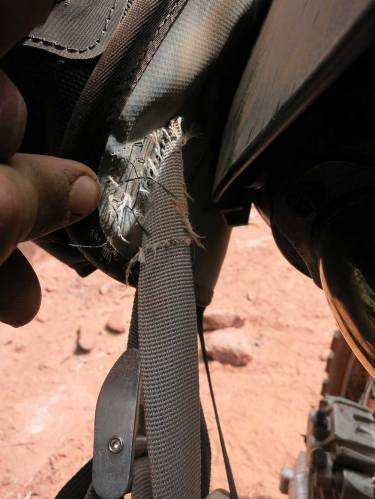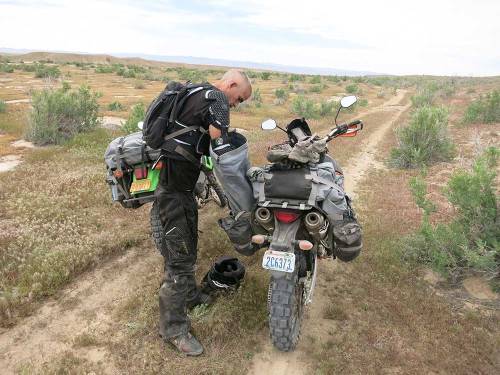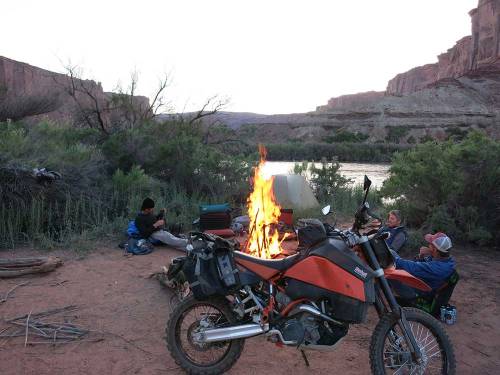Your Cart is Empty
Luggage
Apparel
Events
The Mosko Blog
The Reckless
May 30, 2014
The Reckless
May 30, 2014
We’ve been getting lots of questions about the Rackless pannier/duffle (aka the “Reckless”).
A quick history. We’re designing a bag for riders who don’t have or want a pannier rack. Something to occupy the same market space as the Kriega Overlander 30, the Giant Loop Great Basin/Coyote, and the Wolfman Boulder/Beta type bags. We want it to have the same features as our other bags (100% waterproof, bomber construction, easy on/off, easy access to gear without unstrapping, MOLLE expansion panels, exterior pockets, beavertails, impact-abrasion surface armor, etc). Our concept is basically a harness system that holds three removable drybags to the bike.
This is where we started, a bag strapped to a bike.
Then we went through several generations of concept sketches
Then we cut and sewed a quick & dirty proto, which we re-cut and re-sewed several times until it was a frankenstein bag. We took some pics, layered computer specs over the top, and sent the cut up proto with the specs to our factory.
With me in Vietnam and Andrew in Hood River, we worked with Anton and David at the factory to translate the original sewn prototype into a working prototype that we could use for testing.
The working prototype arrived in the nick of time, right before we took off for Moab.
I wanted to personally ride with and live out of this bag for the entire week in Moab because I’ve never used a rackless system before. I’ve considered them for my trips to other parts of the world, where I drop in for a month to beg/borrow/steal a bike which may or may not have racks on it. But I never actually bought one, for a variety of reasons which we plan to address in our design.
This was a perfect trip for testing this bag because we were riding/camping/eating, and that’s about it. No going out to bars at night, no spending a few days exploring a city, no trying to keep up with work from the road. Those types of activities require extra gear (shoes, laptop, clean clothes, etc) which takes up space and adds a lot of weight. In Moab I took a pair of jeans, a shirt, an ultralight backpacking kit, food/water/booze, and tools/tubes. Food takes up some space, since I don’t do the freeze-dried thing anymore.
The Reckless has three bags: two on the side and one on top. All three are removable roll-tops with 22oz PVC and welded seam construction, just like a kayak drybag, so they’re 100% waterproof. It’s similar to the 3-bag packing/organization system I’m accustomed to from riding bikes with racks: i.e. two side panniers and a rear duffle. So it was easy to adjust.
The Reckless attaches to the bike with three rear straps.
The legs connect to the passenger footpegs or the frame with two cam lock straps on each side.
The rear duffle (which is way too big in our proto, it will be revised to something smaller) is held in place by two overlapping beavertails, similar to our Backcountry 40 Duffle.
There are two external pockets, one on each leg, which can each fit 2 MSR/Primus style 1L fuel bottles so the rider can carry up to 1 gallon of extra gas. I don’t need the extra fuel so I use the pockets for tools and tubes, because I hate fishing through my bags for tools every time I need to adjust something.
The front of the legs have one MOLLE panel each where you can attach our small MOLLE Storage Pouch (or any other MOLLE accessories you already own) which is good for fuel bottles and/or tools and tubes. You can see the MOLLE pouch in the pic below.
I use it for my 750ml flask, which fits perfectly.
Sometimes it’s nice to have a flask on quick-draw.
I tried storing my water dromedaries in the bottom of the leg outside the drybag, but this interfered with the stiffeners in the back of the drybag, so I moved the dromedaries inside. Either way would work.
There’s a mesh pocket in the rear beavertail which is handy for a toothbrush. We’re revising this pocket to make it longer, because it barely fits a brush.
The beavertail is great for all the same things we already use it for on the Backcountry 40 Duffle and Backcountry 35 Panniers. I used it every day to carry my jacket when it got hot, and also for campsite/cooking garbage after packing up camp. It would also work great for a wet rainfly or rain shell, though we didn’t have much rain when we were there.
We came back with a huge list of revisions. First and foremost: the exhaust heat issue needs to be addressed. My 950 super enduro is the perfect bike to highlight that problem, since it rides hot as hell and the exhaust is very exposed. I’ve destroyed at least 5 drybags (and some of their contents) on those pipes. Giant Loop and Enduristan both sell a heat shield but we didn’t have time to order one so we made our own from aluminum angle. That first version was totally inadequate, as you can see in the pic below.
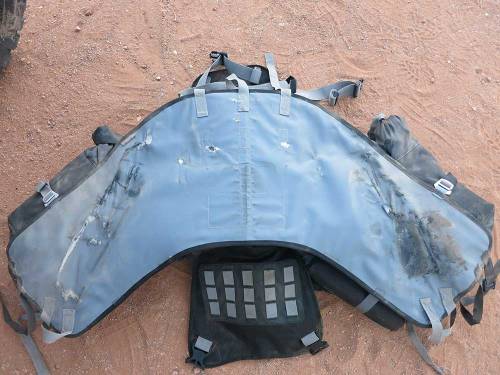
Instead I made a better version out of aluminum cans and hoseclamps to get me through the rest of the trip.
The new heat shields worked fine. Next time I’ll take a store-bought version though. We’re looking at some heat resistant fabric options for the bottom of the bag as well. Vinyl isn’t exactly prized for its heat resistance.
I tore one of the straps connecting the leg to the footpeg in a crash. On our prototype the straps were sewn not bartacked, so we knew this might be an issue. It highlights the amount of stress on this part of the bag, especially since there’s a desire to want to crank these straps down tight. We’re beefing up this part of the bag significantly.
The leg straps seem too exposed in general, so we’re exploring ways to protect them in a crash or slide. If both straps on one side of the bike were to break it would be be a total pain in the ass for the rest of the trip. These straps, and their connection to the bag, are a critical part of the design.
The top beavertail MOLLE panel doesn’t work the way we intended (foreground in pic below). When the bag is stuffed-out, the MOLLE panel is positioned too far forward so anything I put on there hits my back or the bottom of my hydration pack. Which is really annoying. We’re going to either relocate this panel or replace it with a low-profile pocket.
The full revision list is much bigger but those are the main points. One thing I really love about this bag is how easy it is to get gear and food in/out throughout the day. I dig having three separate bags instead of one, because it helps keep me organized. Everything has a home.
Here’s what it looks like with all the drybags removed. It takes about 10 seconds to get them out at the end of the day.
It was fun to ride with less weight on the rear suspension and a load that’s tightly cinched to the bike. I love this bag. I’ll be riding with this one a lot, for sure.

The first – and so far only – Reckless customer was stoked!
The proto is around 60L. We may reduce that a bit in the revision. We’re currently brainstorming a smaller version in the 30-40L range for smaller enduro bikes, to be developed in parallel with the Reckless. Best guess is that both bags will be available this Fall. We’ll offer discounted pre-orders (and a special incentive for mailing list subscribers) once we have final factory costs.
In case you missed the link before, we’re offering discounted pre-orders for the Backcountry 35 Panniers, Backcountry 40 Duffle, Scout 25 Panniers, and Scout 30 Duffle.
Here’s the pre-order link: Pre-Order Information.
If you’ve been patiently waiting for your Free P-38 and starving to death because you had no way to open your canned food… don’t worry, it’s coming. A big mailing went out today. So big that we had to enlist help. Thanks Ava & Rio!!

Warranty and Crash Replacement
We never cut corners during development or manufacturing, so we stand behind our products. If one fails due to a problem with materials or workmanship, we’ll make it right.
Your are successfully subscribed for email notifications.
Notify me when available
We will send you a notification as soon as this product is available again.
Your email is required
We don't share your email with anybody
x





